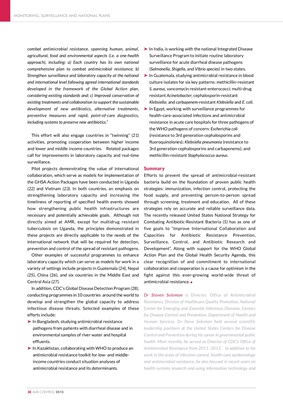
combat antimicrobial resistance, spanning human, animal,
agricultural, food and environmental aspects (i.e. a one-health
approach), including: a) Each country has its own national
comprehensive plan to combat antimicrobial resistance; b)
Strengthen surveillance and laboratory capacity at the national
and international level following agreed international standards
developed in the framework of the Global Action plan,
considering existing standards and; c) Improved conservation of
existing treatments and collaboration to support the sustainable
development of new antibiotics, alternative treatments,
preventive measures and rapid, point-of-care diagnostics,
including systems to preserve new antibiotics."
This effort will also engage countries in "twinning" (21)
activities, promoting cooperation between higher income
and lower and middle income countries. Related packages
call for improvements in laboratory capacity and real-time
surveillance.
Pilot projects demonstrating the value of international
collaboration, which serve as models for implementation of
the GHSA Action Packages have been conducted in Uganda
(22) and Vietnam (23). In both countries, an emphasis on
strengthening laboratory capacity and increasing the
timeliness of reporting of specified health events showed
how strengthening public health infrastructures are
necessary and potentially achievable goals. Although not
directly aimed at AMR, except for multidrug resistant
tuberculosis on Uganda, the principles demonstrated in
these projects are directly applicable to the needs of the
international network that will be required for detection,
prevention and control of the spread of resistant pathogens.
Other examples of successful programmes to enhance
laboratory capacity which can serve as models for work in a
variety of settings include projects in Guatemala (24), Nepal
(25), China (26), and six countries in the Middle East and
Central Asia (27).
In addition, CDC's Global Disease Detection Program (28),
conducting programmes in 10 countries around the world to
develop and strengthen the global capacity to address
infectious disease threats. Selected examples of these
efforts include:
‰ In Bangladesh, studying antimicrobial resistance
pathogens from patients with diarrheal disease and in
environmental samples of river water and hospital
effluents.
‰ In Kazakhstan, collaborating with WHO to produce an
antimicrobial resistance toolkit for low- and middleincome
countries conduct situation analyses of
antimicrobial resistance and its determinants.
‰ In India, is working with the national Integrated Disease
Surveillance Program to initiate routine laboratory
surveillance for acute diarrheal disease pathogens
(Salmonella, Shigella, and Vibrio species) in two states.
‰ In Guatemala, studying antimicrobial resistance in blood
culture isolates for six key patterns: methicillin-resistant
S. aureus, vancomycin resistant-enterococci; multi-drug
resistant Acinetobacter; cephalosporin-resistant
Klebsiella; and carbapenem-resistant Klebsiella and E. coli.
‰ In Egypt, working with surveillance programmes for
health-care-associated infections and antimicrobial
resistance in acute care hospitals for three pathogens of
the WHO pathogens of concern: Escherichia coli
(resistance to 3rd generation cephalosporins and
fluoroquinolones); Klebsiella pneumonia (resistance to
3rd generation cephalosporins and carbapenems); and
methicillin-resistant Staphylococcus aureus.
Summary
Efforts to prevent the spread of antimicrobial-resistant
bacteria build on the foundation of proven public health
strategies: immunization, infection control, protecting the
food supply, and preventing person-to-person spread
through screening, treatment and education. All of these
strategies rely on accurate and reliable surveillance data.
The recently released United States National Strategy for
Combating Antibiotic-Resistant Bacteria (5) has as one of
five goals to "Improve International Collaboration and
Capacities for Antibiotic Resistance Prevention,
Surveillance, Control, and Antibiotic Research and
Development". Along with support for the WHO Global
Action Plan and the Global Health Security Agenda, this
clear recognition of and commitment to international
collaboration and cooperation is a cause for optimism in the
fight against this ever-growing world-wide threat of
antimicrobial resistance. l
Dr Steven Solomon is Director, Office of Antimicrobial
Resistance, Division of Healthcare Quality Promotion, National
Center for Emerging and Zoonotic Infectious Diseases, Centers
for Disease Control and Prevention, Department of Health and
Human Services. Dr Steve Solomon held several scientific
leadership positions at the United States Centers for Disease
Control and Prevention during his career in governmental public
health. Most recently, he served as Director of CDC's Office of
Antimicrobial Resistance from 2011-2015. In addition to his
work in the areas of infection control, health-care epidemiology
and antimicrobial resistance, he also focused in recent years on
health systems research and using information technology and
MONITORING, SURVEILLANCE AND NATIONAL PLANS
38 AMR CONTROL 2015